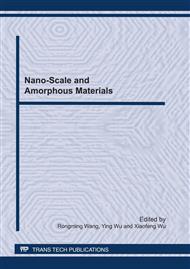p.116
p.122
p.127
p.135
p.141
p.148
p.153
p.158
p.162
Growth of Carbon Nanotubes in Calcium Phosphate Matrix with Different Ca/P Molar Ratio
Abstract:
This paper reports that carbon nanotubes (CNTs) can be successfully grown from calcium phosphate matrix without additional catalysis of transition metal by chemical vapor deposition (CVD) using acetylene as carbon source. There is a great difference in the CNT growth from the matrix prepared with the different initial Ca/P molar ratio. The matrix prepared with lower initial Ca/P molar ratio is favorable for the growth of CNTs. A number of multi-walled CNTs with the diameter of 25~40 nm and 15~25 nm can be produced from the matrix with initial Ca/P molar ratio of 1.5 and 1.625, respectively, while no CNTs can be grown from the matrix with initial Ca/P molar ratio of 1.67. Tricalcium phosphate and hydroxyapatite crystallites with crystal size smaller than 50 nm besides carbon crystals are found in the as-obtained powders prepared with initial Ca/P molar ratio of 1.5 and 1.625. Compared with the growth of CNTs produced from all the matrixes, it is found that the CNTs grown from this matrix with Ca/P molar ratio of 1.5 have the longest tube length, cleanest and smoothest wall surface, and the content of CNTs is highest.
Info:
Periodical:
Pages:
141-147
Citation:
Online since:
June 2011
Authors:
Price:
Сopyright:
© 2011 Trans Tech Publications Ltd. All Rights Reserved
Share:
Citation:


